Vodafone Group Plc: Comprehensive Business Strategy Analysis
VerifiedAdded on 2023/06/10
|13
|4010
|189
Report
AI Summary
This report provides a comprehensive analysis of Vodafone Group Plc's business strategy, examining both its internal and external environments. It begins by outlining Vodafone's vision, mission, and objectives, followed by an evaluation of the company's internal environment using SWOT and value chain analyses. The external environment is assessed through Porter's Five Forces and PESTLE analyses, identifying key opportunities and threats. The report then explores different strategic directions available to Vodafone, offering recommendations with justifications and a strategic management plan. Ultimately, the analysis aims to provide insights into Vodafone's strategic positioning and potential pathways for sustainable growth and competitive advantage in the telecommunications industry. Desklib offers a variety of resources, including past papers and solved assignments, to aid students in their academic pursuits.
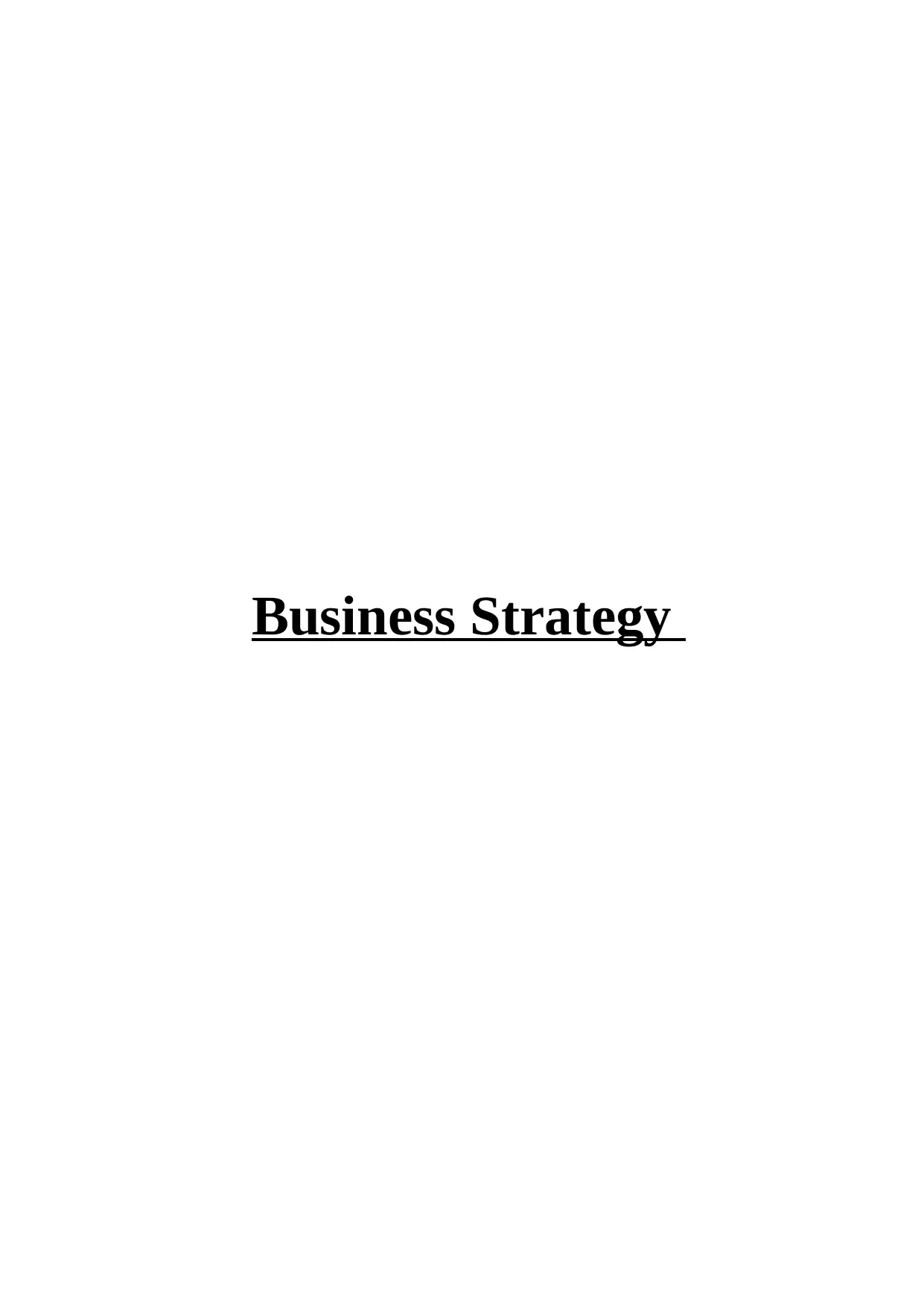
Business Strategy
Paraphrase This Document
Need a fresh take? Get an instant paraphrase of this document with our AI Paraphraser
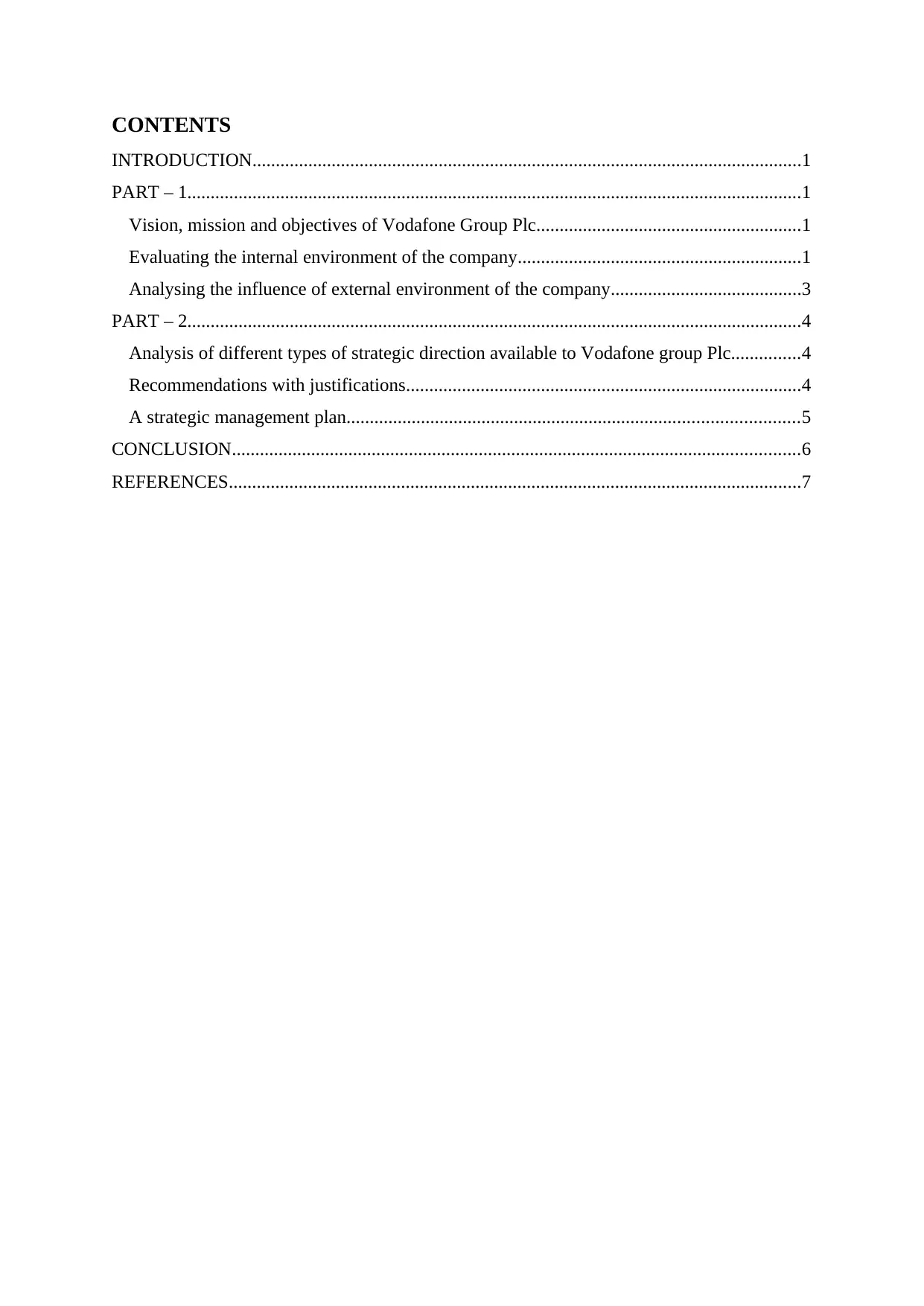
CONTENTS
INTRODUCTION......................................................................................................................1
PART – 1....................................................................................................................................1
Vision, mission and objectives of Vodafone Group Plc.........................................................1
Evaluating the internal environment of the company.............................................................1
Analysing the influence of external environment of the company.........................................3
PART – 2....................................................................................................................................4
Analysis of different types of strategic direction available to Vodafone group Plc...............4
Recommendations with justifications.....................................................................................4
A strategic management plan.................................................................................................5
CONCLUSION..........................................................................................................................6
REFERENCES...........................................................................................................................7
INTRODUCTION......................................................................................................................1
PART – 1....................................................................................................................................1
Vision, mission and objectives of Vodafone Group Plc.........................................................1
Evaluating the internal environment of the company.............................................................1
Analysing the influence of external environment of the company.........................................3
PART – 2....................................................................................................................................4
Analysis of different types of strategic direction available to Vodafone group Plc...............4
Recommendations with justifications.....................................................................................4
A strategic management plan.................................................................................................5
CONCLUSION..........................................................................................................................6
REFERENCES...........................................................................................................................7
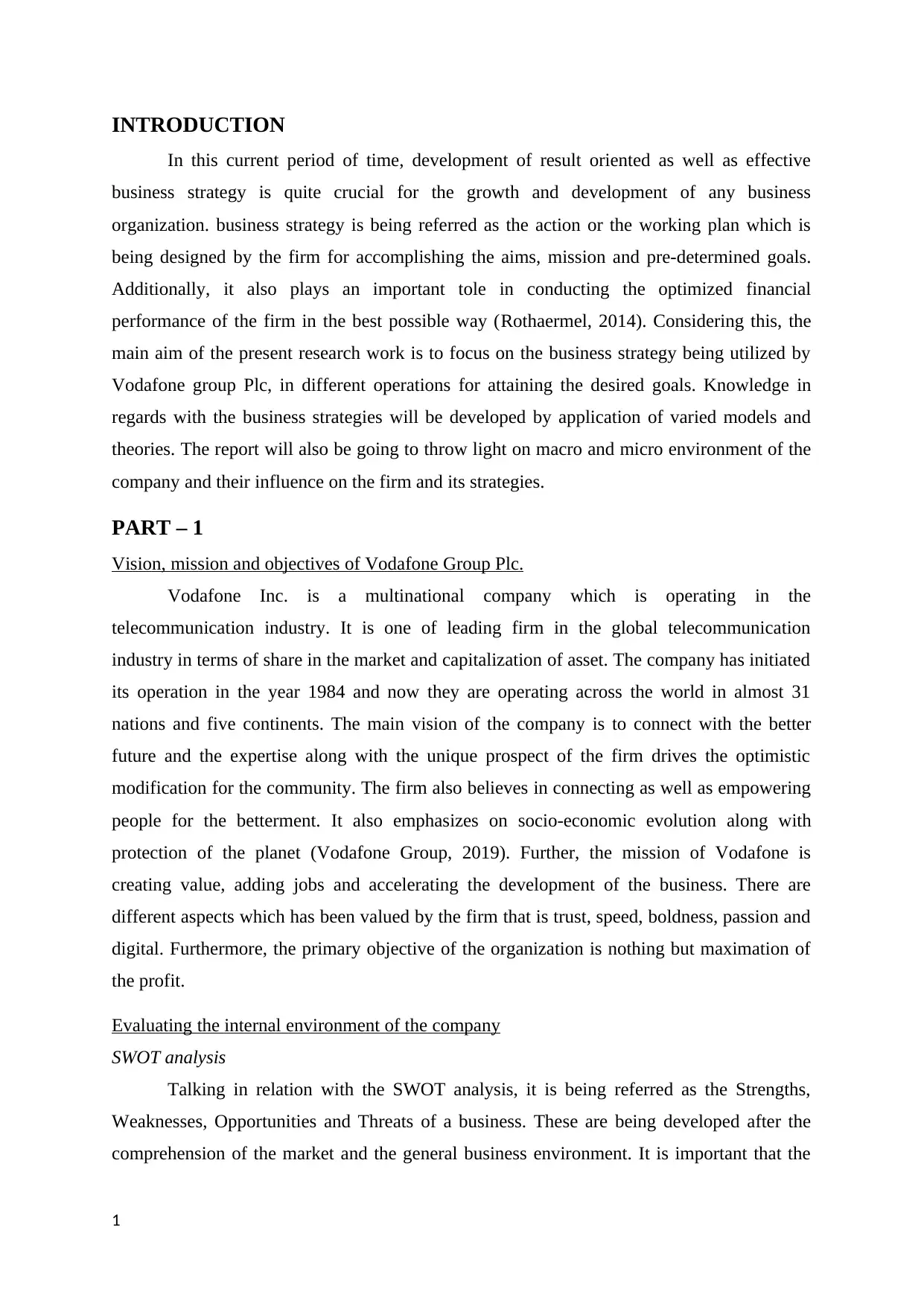
INTRODUCTION
In this current period of time, development of result oriented as well as effective
business strategy is quite crucial for the growth and development of any business
organization. business strategy is being referred as the action or the working plan which is
being designed by the firm for accomplishing the aims, mission and pre-determined goals.
Additionally, it also plays an important tole in conducting the optimized financial
performance of the firm in the best possible way (Rothaermel, 2014). Considering this, the
main aim of the present research work is to focus on the business strategy being utilized by
Vodafone group Plc, in different operations for attaining the desired goals. Knowledge in
regards with the business strategies will be developed by application of varied models and
theories. The report will also be going to throw light on macro and micro environment of the
company and their influence on the firm and its strategies.
PART – 1
Vision, mission and objectives of Vodafone Group Plc.
Vodafone Inc. is a multinational company which is operating in the
telecommunication industry. It is one of leading firm in the global telecommunication
industry in terms of share in the market and capitalization of asset. The company has initiated
its operation in the year 1984 and now they are operating across the world in almost 31
nations and five continents. The main vision of the company is to connect with the better
future and the expertise along with the unique prospect of the firm drives the optimistic
modification for the community. The firm also believes in connecting as well as empowering
people for the betterment. It also emphasizes on socio-economic evolution along with
protection of the planet (Vodafone Group, 2019). Further, the mission of Vodafone is
creating value, adding jobs and accelerating the development of the business. There are
different aspects which has been valued by the firm that is trust, speed, boldness, passion and
digital. Furthermore, the primary objective of the organization is nothing but maximation of
the profit.
Evaluating the internal environment of the company
SWOT analysis
Talking in relation with the SWOT analysis, it is being referred as the Strengths,
Weaknesses, Opportunities and Threats of a business. These are being developed after the
comprehension of the market and the general business environment. It is important that the
1
In this current period of time, development of result oriented as well as effective
business strategy is quite crucial for the growth and development of any business
organization. business strategy is being referred as the action or the working plan which is
being designed by the firm for accomplishing the aims, mission and pre-determined goals.
Additionally, it also plays an important tole in conducting the optimized financial
performance of the firm in the best possible way (Rothaermel, 2014). Considering this, the
main aim of the present research work is to focus on the business strategy being utilized by
Vodafone group Plc, in different operations for attaining the desired goals. Knowledge in
regards with the business strategies will be developed by application of varied models and
theories. The report will also be going to throw light on macro and micro environment of the
company and their influence on the firm and its strategies.
PART – 1
Vision, mission and objectives of Vodafone Group Plc.
Vodafone Inc. is a multinational company which is operating in the
telecommunication industry. It is one of leading firm in the global telecommunication
industry in terms of share in the market and capitalization of asset. The company has initiated
its operation in the year 1984 and now they are operating across the world in almost 31
nations and five continents. The main vision of the company is to connect with the better
future and the expertise along with the unique prospect of the firm drives the optimistic
modification for the community. The firm also believes in connecting as well as empowering
people for the betterment. It also emphasizes on socio-economic evolution along with
protection of the planet (Vodafone Group, 2019). Further, the mission of Vodafone is
creating value, adding jobs and accelerating the development of the business. There are
different aspects which has been valued by the firm that is trust, speed, boldness, passion and
digital. Furthermore, the primary objective of the organization is nothing but maximation of
the profit.
Evaluating the internal environment of the company
SWOT analysis
Talking in relation with the SWOT analysis, it is being referred as the Strengths,
Weaknesses, Opportunities and Threats of a business. These are being developed after the
comprehension of the market and the general business environment. It is important that the
1
⊘ This is a preview!⊘
Do you want full access?
Subscribe today to unlock all pages.

Trusted by 1+ million students worldwide
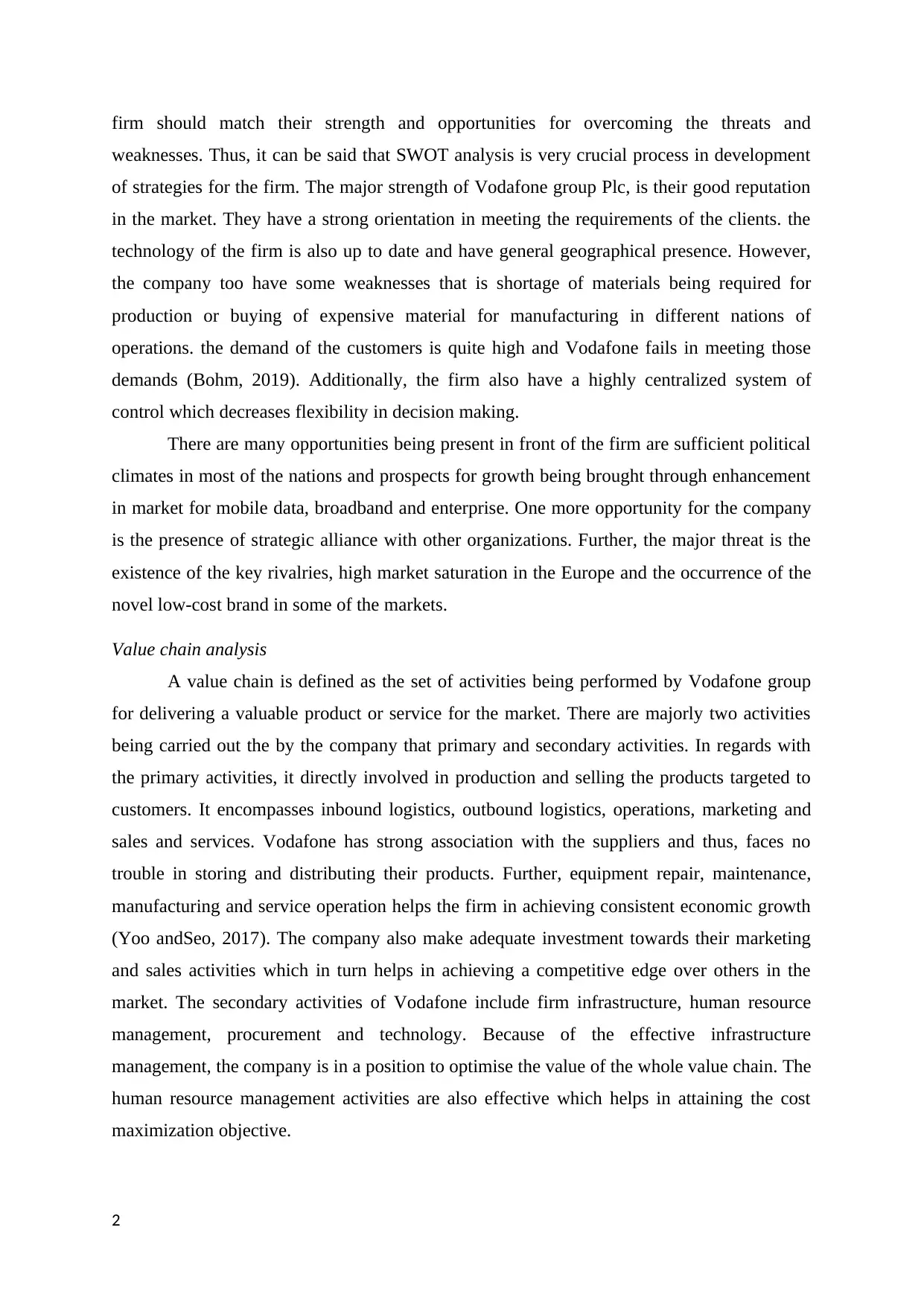
firm should match their strength and opportunities for overcoming the threats and
weaknesses. Thus, it can be said that SWOT analysis is very crucial process in development
of strategies for the firm. The major strength of Vodafone group Plc, is their good reputation
in the market. They have a strong orientation in meeting the requirements of the clients. the
technology of the firm is also up to date and have general geographical presence. However,
the company too have some weaknesses that is shortage of materials being required for
production or buying of expensive material for manufacturing in different nations of
operations. the demand of the customers is quite high and Vodafone fails in meeting those
demands (Bohm, 2019). Additionally, the firm also have a highly centralized system of
control which decreases flexibility in decision making.
There are many opportunities being present in front of the firm are sufficient political
climates in most of the nations and prospects for growth being brought through enhancement
in market for mobile data, broadband and enterprise. One more opportunity for the company
is the presence of strategic alliance with other organizations. Further, the major threat is the
existence of the key rivalries, high market saturation in the Europe and the occurrence of the
novel low-cost brand in some of the markets.
Value chain analysis
A value chain is defined as the set of activities being performed by Vodafone group
for delivering a valuable product or service for the market. There are majorly two activities
being carried out the by the company that primary and secondary activities. In regards with
the primary activities, it directly involved in production and selling the products targeted to
customers. It encompasses inbound logistics, outbound logistics, operations, marketing and
sales and services. Vodafone has strong association with the suppliers and thus, faces no
trouble in storing and distributing their products. Further, equipment repair, maintenance,
manufacturing and service operation helps the firm in achieving consistent economic growth
(Yoo andSeo, 2017). The company also make adequate investment towards their marketing
and sales activities which in turn helps in achieving a competitive edge over others in the
market. The secondary activities of Vodafone include firm infrastructure, human resource
management, procurement and technology. Because of the effective infrastructure
management, the company is in a position to optimise the value of the whole value chain. The
human resource management activities are also effective which helps in attaining the cost
maximization objective.
2
weaknesses. Thus, it can be said that SWOT analysis is very crucial process in development
of strategies for the firm. The major strength of Vodafone group Plc, is their good reputation
in the market. They have a strong orientation in meeting the requirements of the clients. the
technology of the firm is also up to date and have general geographical presence. However,
the company too have some weaknesses that is shortage of materials being required for
production or buying of expensive material for manufacturing in different nations of
operations. the demand of the customers is quite high and Vodafone fails in meeting those
demands (Bohm, 2019). Additionally, the firm also have a highly centralized system of
control which decreases flexibility in decision making.
There are many opportunities being present in front of the firm are sufficient political
climates in most of the nations and prospects for growth being brought through enhancement
in market for mobile data, broadband and enterprise. One more opportunity for the company
is the presence of strategic alliance with other organizations. Further, the major threat is the
existence of the key rivalries, high market saturation in the Europe and the occurrence of the
novel low-cost brand in some of the markets.
Value chain analysis
A value chain is defined as the set of activities being performed by Vodafone group
for delivering a valuable product or service for the market. There are majorly two activities
being carried out the by the company that primary and secondary activities. In regards with
the primary activities, it directly involved in production and selling the products targeted to
customers. It encompasses inbound logistics, outbound logistics, operations, marketing and
sales and services. Vodafone has strong association with the suppliers and thus, faces no
trouble in storing and distributing their products. Further, equipment repair, maintenance,
manufacturing and service operation helps the firm in achieving consistent economic growth
(Yoo andSeo, 2017). The company also make adequate investment towards their marketing
and sales activities which in turn helps in achieving a competitive edge over others in the
market. The secondary activities of Vodafone include firm infrastructure, human resource
management, procurement and technology. Because of the effective infrastructure
management, the company is in a position to optimise the value of the whole value chain. The
human resource management activities are also effective which helps in attaining the cost
maximization objective.
2
Paraphrase This Document
Need a fresh take? Get an instant paraphrase of this document with our AI Paraphraser
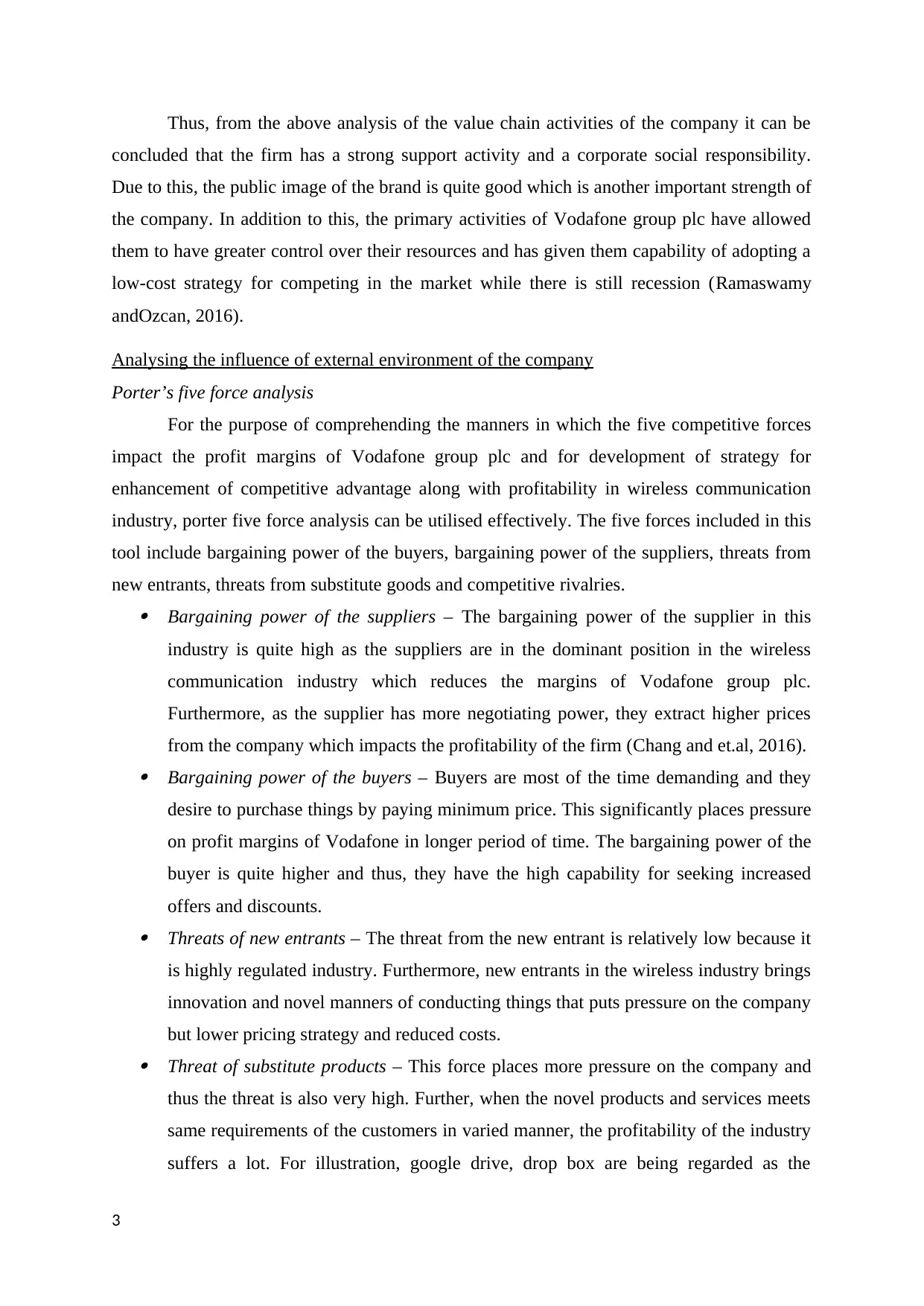
Thus, from the above analysis of the value chain activities of the company it can be
concluded that the firm has a strong support activity and a corporate social responsibility.
Due to this, the public image of the brand is quite good which is another important strength of
the company. In addition to this, the primary activities of Vodafone group plc have allowed
them to have greater control over their resources and has given them capability of adopting a
low-cost strategy for competing in the market while there is still recession (Ramaswamy
andOzcan, 2016).
Analysing the influence of external environment of the company
Porter’s five force analysis
For the purpose of comprehending the manners in which the five competitive forces
impact the profit margins of Vodafone group plc and for development of strategy for
enhancement of competitive advantage along with profitability in wireless communication
industry, porter five force analysis can be utilised effectively. The five forces included in this
tool include bargaining power of the buyers, bargaining power of the suppliers, threats from
new entrants, threats from substitute goods and competitive rivalries. Bargaining power of the suppliers – The bargaining power of the supplier in this
industry is quite high as the suppliers are in the dominant position in the wireless
communication industry which reduces the margins of Vodafone group plc.
Furthermore, as the supplier has more negotiating power, they extract higher prices
from the company which impacts the profitability of the firm (Chang and et.al, 2016). Bargaining power of the buyers – Buyers are most of the time demanding and they
desire to purchase things by paying minimum price. This significantly places pressure
on profit margins of Vodafone in longer period of time. The bargaining power of the
buyer is quite higher and thus, they have the high capability for seeking increased
offers and discounts. Threats of new entrants – The threat from the new entrant is relatively low because it
is highly regulated industry. Furthermore, new entrants in the wireless industry brings
innovation and novel manners of conducting things that puts pressure on the company
but lower pricing strategy and reduced costs. Threat of substitute products – This force places more pressure on the company and
thus the threat is also very high. Further, when the novel products and services meets
same requirements of the customers in varied manner, the profitability of the industry
suffers a lot. For illustration, google drive, drop box are being regarded as the
3
concluded that the firm has a strong support activity and a corporate social responsibility.
Due to this, the public image of the brand is quite good which is another important strength of
the company. In addition to this, the primary activities of Vodafone group plc have allowed
them to have greater control over their resources and has given them capability of adopting a
low-cost strategy for competing in the market while there is still recession (Ramaswamy
andOzcan, 2016).
Analysing the influence of external environment of the company
Porter’s five force analysis
For the purpose of comprehending the manners in which the five competitive forces
impact the profit margins of Vodafone group plc and for development of strategy for
enhancement of competitive advantage along with profitability in wireless communication
industry, porter five force analysis can be utilised effectively. The five forces included in this
tool include bargaining power of the buyers, bargaining power of the suppliers, threats from
new entrants, threats from substitute goods and competitive rivalries. Bargaining power of the suppliers – The bargaining power of the supplier in this
industry is quite high as the suppliers are in the dominant position in the wireless
communication industry which reduces the margins of Vodafone group plc.
Furthermore, as the supplier has more negotiating power, they extract higher prices
from the company which impacts the profitability of the firm (Chang and et.al, 2016). Bargaining power of the buyers – Buyers are most of the time demanding and they
desire to purchase things by paying minimum price. This significantly places pressure
on profit margins of Vodafone in longer period of time. The bargaining power of the
buyer is quite higher and thus, they have the high capability for seeking increased
offers and discounts. Threats of new entrants – The threat from the new entrant is relatively low because it
is highly regulated industry. Furthermore, new entrants in the wireless industry brings
innovation and novel manners of conducting things that puts pressure on the company
but lower pricing strategy and reduced costs. Threat of substitute products – This force places more pressure on the company and
thus the threat is also very high. Further, when the novel products and services meets
same requirements of the customers in varied manner, the profitability of the industry
suffers a lot. For illustration, google drive, drop box are being regarded as the
3
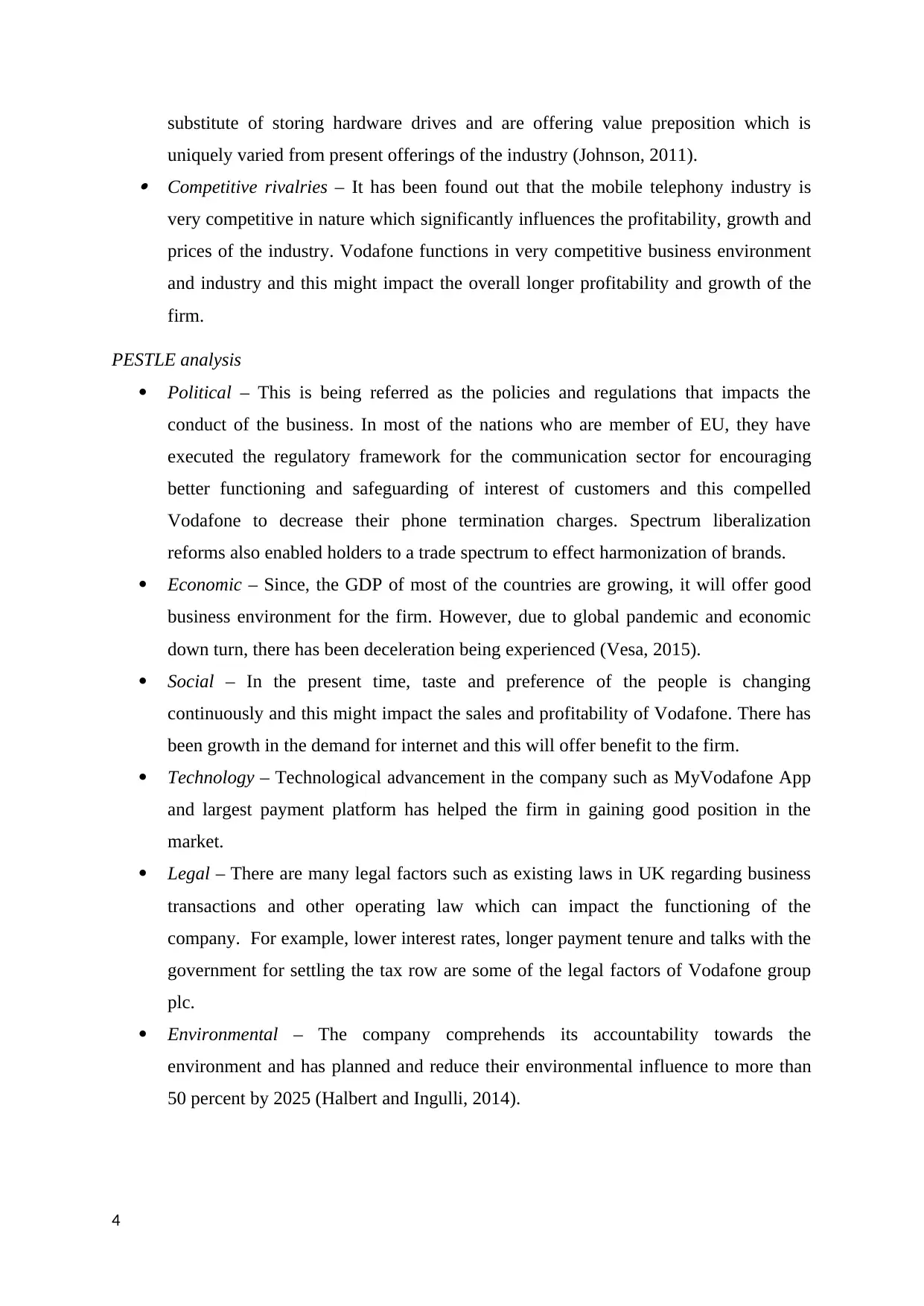
substitute of storing hardware drives and are offering value preposition which is
uniquely varied from present offerings of the industry (Johnson, 2011). Competitive rivalries – It has been found out that the mobile telephony industry is
very competitive in nature which significantly influences the profitability, growth and
prices of the industry. Vodafone functions in very competitive business environment
and industry and this might impact the overall longer profitability and growth of the
firm.
PESTLE analysis
Political – This is being referred as the policies and regulations that impacts the
conduct of the business. In most of the nations who are member of EU, they have
executed the regulatory framework for the communication sector for encouraging
better functioning and safeguarding of interest of customers and this compelled
Vodafone to decrease their phone termination charges. Spectrum liberalization
reforms also enabled holders to a trade spectrum to effect harmonization of brands.
Economic – Since, the GDP of most of the countries are growing, it will offer good
business environment for the firm. However, due to global pandemic and economic
down turn, there has been deceleration being experienced (Vesa, 2015).
Social – In the present time, taste and preference of the people is changing
continuously and this might impact the sales and profitability of Vodafone. There has
been growth in the demand for internet and this will offer benefit to the firm.
Technology – Technological advancement in the company such as MyVodafone App
and largest payment platform has helped the firm in gaining good position in the
market.
Legal – There are many legal factors such as existing laws in UK regarding business
transactions and other operating law which can impact the functioning of the
company. For example, lower interest rates, longer payment tenure and talks with the
government for settling the tax row are some of the legal factors of Vodafone group
plc.
Environmental – The company comprehends its accountability towards the
environment and has planned and reduce their environmental influence to more than
50 percent by 2025 (Halbert and Ingulli, 2014).
4
uniquely varied from present offerings of the industry (Johnson, 2011). Competitive rivalries – It has been found out that the mobile telephony industry is
very competitive in nature which significantly influences the profitability, growth and
prices of the industry. Vodafone functions in very competitive business environment
and industry and this might impact the overall longer profitability and growth of the
firm.
PESTLE analysis
Political – This is being referred as the policies and regulations that impacts the
conduct of the business. In most of the nations who are member of EU, they have
executed the regulatory framework for the communication sector for encouraging
better functioning and safeguarding of interest of customers and this compelled
Vodafone to decrease their phone termination charges. Spectrum liberalization
reforms also enabled holders to a trade spectrum to effect harmonization of brands.
Economic – Since, the GDP of most of the countries are growing, it will offer good
business environment for the firm. However, due to global pandemic and economic
down turn, there has been deceleration being experienced (Vesa, 2015).
Social – In the present time, taste and preference of the people is changing
continuously and this might impact the sales and profitability of Vodafone. There has
been growth in the demand for internet and this will offer benefit to the firm.
Technology – Technological advancement in the company such as MyVodafone App
and largest payment platform has helped the firm in gaining good position in the
market.
Legal – There are many legal factors such as existing laws in UK regarding business
transactions and other operating law which can impact the functioning of the
company. For example, lower interest rates, longer payment tenure and talks with the
government for settling the tax row are some of the legal factors of Vodafone group
plc.
Environmental – The company comprehends its accountability towards the
environment and has planned and reduce their environmental influence to more than
50 percent by 2025 (Halbert and Ingulli, 2014).
4
⊘ This is a preview!⊘
Do you want full access?
Subscribe today to unlock all pages.

Trusted by 1+ million students worldwide
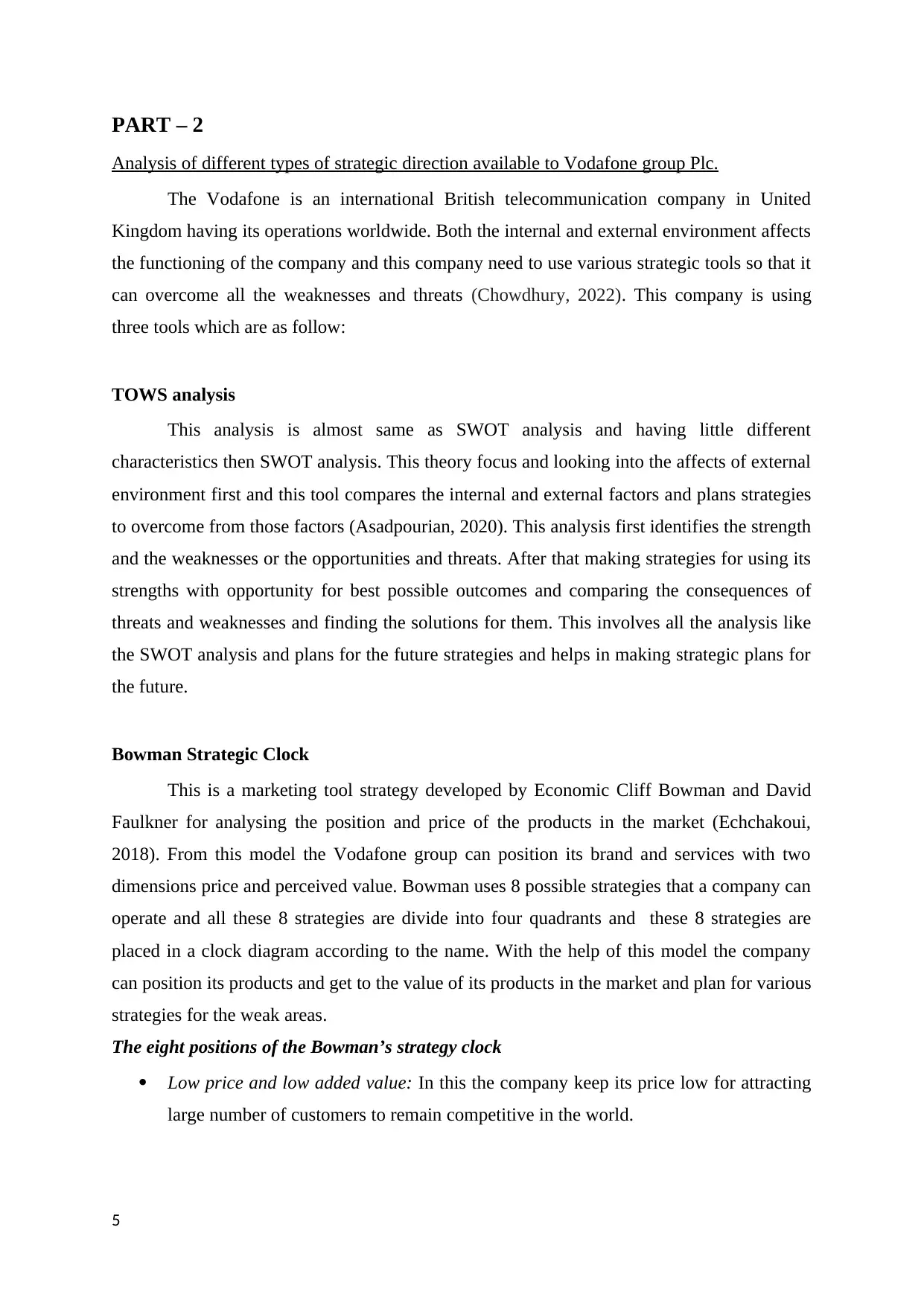
PART – 2
Analysis of different types of strategic direction available to Vodafone group Plc.
The Vodafone is an international British telecommunication company in United
Kingdom having its operations worldwide. Both the internal and external environment affects
the functioning of the company and this company need to use various strategic tools so that it
can overcome all the weaknesses and threats (Chowdhury, 2022). This company is using
three tools which are as follow:
TOWS analysis
This analysis is almost same as SWOT analysis and having little different
characteristics then SWOT analysis. This theory focus and looking into the affects of external
environment first and this tool compares the internal and external factors and plans strategies
to overcome from those factors (Asadpourian, 2020). This analysis first identifies the strength
and the weaknesses or the opportunities and threats. After that making strategies for using its
strengths with opportunity for best possible outcomes and comparing the consequences of
threats and weaknesses and finding the solutions for them. This involves all the analysis like
the SWOT analysis and plans for the future strategies and helps in making strategic plans for
the future.
Bowman Strategic Clock
This is a marketing tool strategy developed by Economic Cliff Bowman and David
Faulkner for analysing the position and price of the products in the market (Echchakoui,
2018). From this model the Vodafone group can position its brand and services with two
dimensions price and perceived value. Bowman uses 8 possible strategies that a company can
operate and all these 8 strategies are divide into four quadrants and these 8 strategies are
placed in a clock diagram according to the name. With the help of this model the company
can position its products and get to the value of its products in the market and plan for various
strategies for the weak areas.
The eight positions of the Bowman’s strategy clock
Low price and low added value: In this the company keep its price low for attracting
large number of customers to remain competitive in the world.
5
Analysis of different types of strategic direction available to Vodafone group Plc.
The Vodafone is an international British telecommunication company in United
Kingdom having its operations worldwide. Both the internal and external environment affects
the functioning of the company and this company need to use various strategic tools so that it
can overcome all the weaknesses and threats (Chowdhury, 2022). This company is using
three tools which are as follow:
TOWS analysis
This analysis is almost same as SWOT analysis and having little different
characteristics then SWOT analysis. This theory focus and looking into the affects of external
environment first and this tool compares the internal and external factors and plans strategies
to overcome from those factors (Asadpourian, 2020). This analysis first identifies the strength
and the weaknesses or the opportunities and threats. After that making strategies for using its
strengths with opportunity for best possible outcomes and comparing the consequences of
threats and weaknesses and finding the solutions for them. This involves all the analysis like
the SWOT analysis and plans for the future strategies and helps in making strategic plans for
the future.
Bowman Strategic Clock
This is a marketing tool strategy developed by Economic Cliff Bowman and David
Faulkner for analysing the position and price of the products in the market (Echchakoui,
2018). From this model the Vodafone group can position its brand and services with two
dimensions price and perceived value. Bowman uses 8 possible strategies that a company can
operate and all these 8 strategies are divide into four quadrants and these 8 strategies are
placed in a clock diagram according to the name. With the help of this model the company
can position its products and get to the value of its products in the market and plan for various
strategies for the weak areas.
The eight positions of the Bowman’s strategy clock
Low price and low added value: In this the company keep its price low for attracting
large number of customers to remain competitive in the world.
5
Paraphrase This Document
Need a fresh take? Get an instant paraphrase of this document with our AI Paraphraser
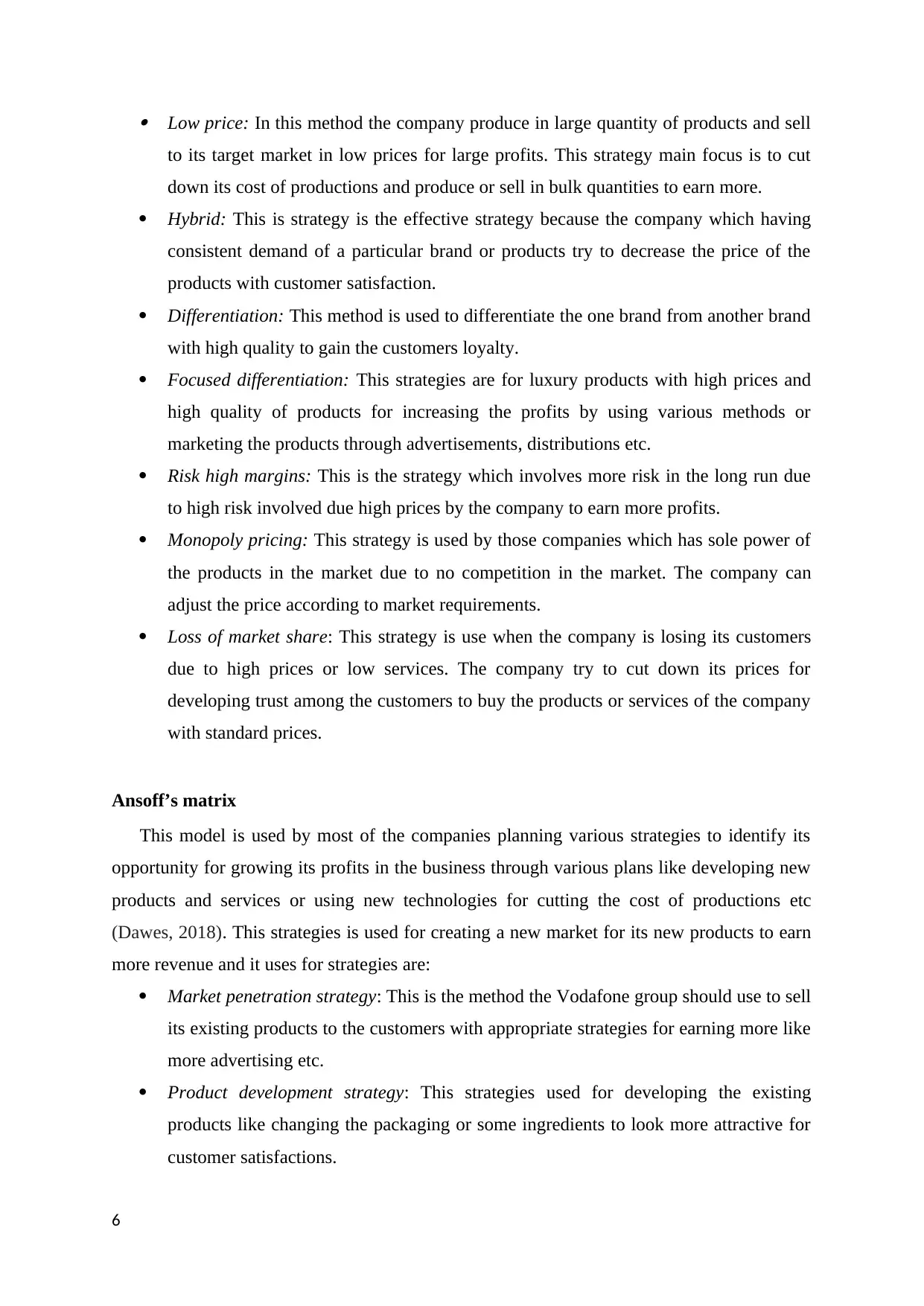
Low price: In this method the company produce in large quantity of products and sell
to its target market in low prices for large profits. This strategy main focus is to cut
down its cost of productions and produce or sell in bulk quantities to earn more.
Hybrid: This is strategy is the effective strategy because the company which having
consistent demand of a particular brand or products try to decrease the price of the
products with customer satisfaction.
Differentiation: This method is used to differentiate the one brand from another brand
with high quality to gain the customers loyalty.
Focused differentiation: This strategies are for luxury products with high prices and
high quality of products for increasing the profits by using various methods or
marketing the products through advertisements, distributions etc.
Risk high margins: This is the strategy which involves more risk in the long run due
to high risk involved due high prices by the company to earn more profits.
Monopoly pricing: This strategy is used by those companies which has sole power of
the products in the market due to no competition in the market. The company can
adjust the price according to market requirements.
Loss of market share: This strategy is use when the company is losing its customers
due to high prices or low services. The company try to cut down its prices for
developing trust among the customers to buy the products or services of the company
with standard prices.
Ansoff’s matrix
This model is used by most of the companies planning various strategies to identify its
opportunity for growing its profits in the business through various plans like developing new
products and services or using new technologies for cutting the cost of productions etc
(Dawes, 2018). This strategies is used for creating a new market for its new products to earn
more revenue and it uses for strategies are:
Market penetration strategy: This is the method the Vodafone group should use to sell
its existing products to the customers with appropriate strategies for earning more like
more advertising etc.
Product development strategy: This strategies used for developing the existing
products like changing the packaging or some ingredients to look more attractive for
customer satisfactions.
6
to its target market in low prices for large profits. This strategy main focus is to cut
down its cost of productions and produce or sell in bulk quantities to earn more.
Hybrid: This is strategy is the effective strategy because the company which having
consistent demand of a particular brand or products try to decrease the price of the
products with customer satisfaction.
Differentiation: This method is used to differentiate the one brand from another brand
with high quality to gain the customers loyalty.
Focused differentiation: This strategies are for luxury products with high prices and
high quality of products for increasing the profits by using various methods or
marketing the products through advertisements, distributions etc.
Risk high margins: This is the strategy which involves more risk in the long run due
to high risk involved due high prices by the company to earn more profits.
Monopoly pricing: This strategy is used by those companies which has sole power of
the products in the market due to no competition in the market. The company can
adjust the price according to market requirements.
Loss of market share: This strategy is use when the company is losing its customers
due to high prices or low services. The company try to cut down its prices for
developing trust among the customers to buy the products or services of the company
with standard prices.
Ansoff’s matrix
This model is used by most of the companies planning various strategies to identify its
opportunity for growing its profits in the business through various plans like developing new
products and services or using new technologies for cutting the cost of productions etc
(Dawes, 2018). This strategies is used for creating a new market for its new products to earn
more revenue and it uses for strategies are:
Market penetration strategy: This is the method the Vodafone group should use to sell
its existing products to the customers with appropriate strategies for earning more like
more advertising etc.
Product development strategy: This strategies used for developing the existing
products like changing the packaging or some ingredients to look more attractive for
customer satisfactions.
6
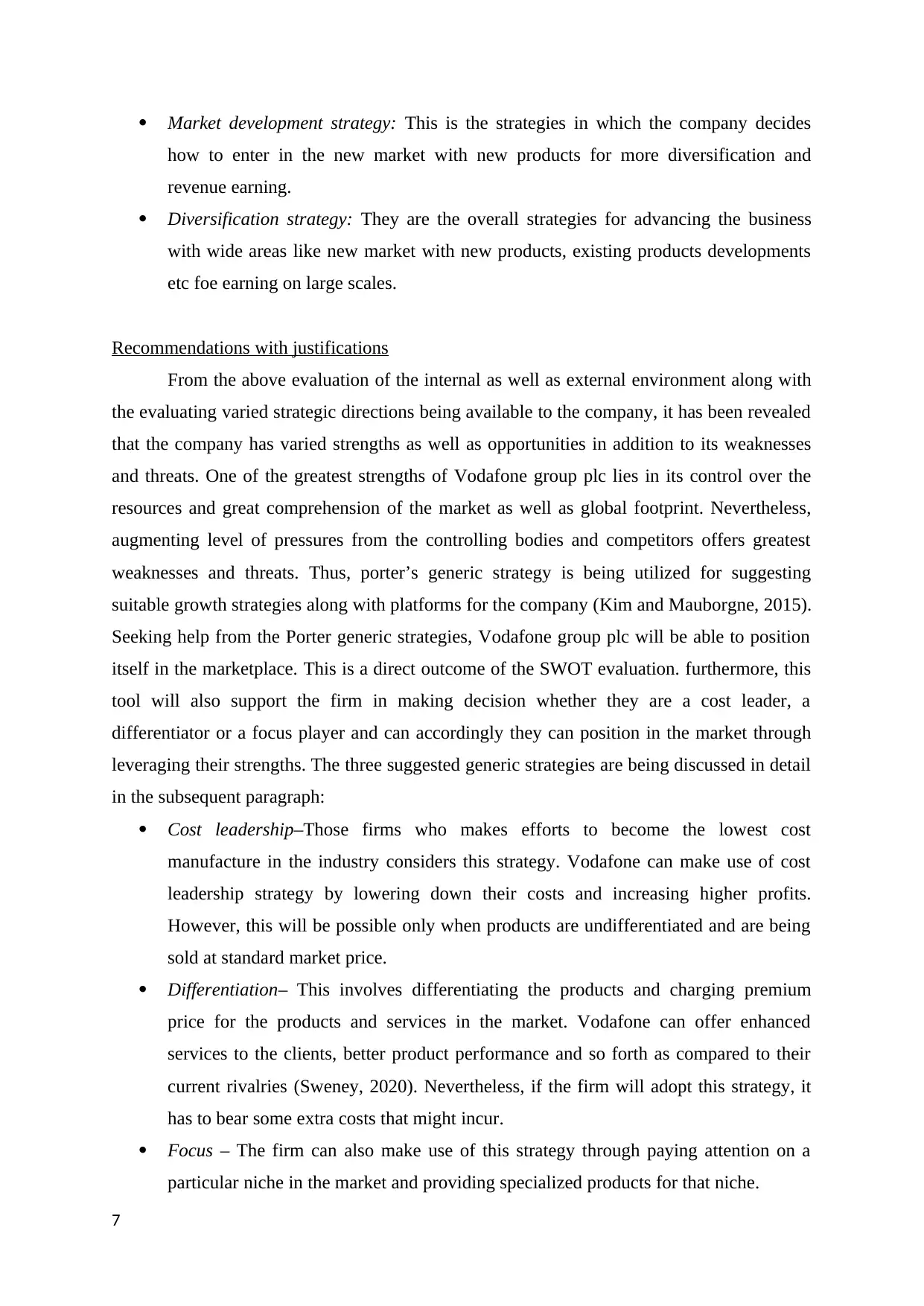
Market development strategy: This is the strategies in which the company decides
how to enter in the new market with new products for more diversification and
revenue earning.
Diversification strategy: They are the overall strategies for advancing the business
with wide areas like new market with new products, existing products developments
etc foe earning on large scales.
Recommendations with justifications
From the above evaluation of the internal as well as external environment along with
the evaluating varied strategic directions being available to the company, it has been revealed
that the company has varied strengths as well as opportunities in addition to its weaknesses
and threats. One of the greatest strengths of Vodafone group plc lies in its control over the
resources and great comprehension of the market as well as global footprint. Nevertheless,
augmenting level of pressures from the controlling bodies and competitors offers greatest
weaknesses and threats. Thus, porter’s generic strategy is being utilized for suggesting
suitable growth strategies along with platforms for the company (Kim and Mauborgne, 2015).
Seeking help from the Porter generic strategies, Vodafone group plc will be able to position
itself in the marketplace. This is a direct outcome of the SWOT evaluation. furthermore, this
tool will also support the firm in making decision whether they are a cost leader, a
differentiator or a focus player and can accordingly they can position in the market through
leveraging their strengths. The three suggested generic strategies are being discussed in detail
in the subsequent paragraph:
Cost leadership–Those firms who makes efforts to become the lowest cost
manufacture in the industry considers this strategy. Vodafone can make use of cost
leadership strategy by lowering down their costs and increasing higher profits.
However, this will be possible only when products are undifferentiated and are being
sold at standard market price.
Differentiation– This involves differentiating the products and charging premium
price for the products and services in the market. Vodafone can offer enhanced
services to the clients, better product performance and so forth as compared to their
current rivalries (Sweney, 2020). Nevertheless, if the firm will adopt this strategy, it
has to bear some extra costs that might incur.
Focus – The firm can also make use of this strategy through paying attention on a
particular niche in the market and providing specialized products for that niche.
7
how to enter in the new market with new products for more diversification and
revenue earning.
Diversification strategy: They are the overall strategies for advancing the business
with wide areas like new market with new products, existing products developments
etc foe earning on large scales.
Recommendations with justifications
From the above evaluation of the internal as well as external environment along with
the evaluating varied strategic directions being available to the company, it has been revealed
that the company has varied strengths as well as opportunities in addition to its weaknesses
and threats. One of the greatest strengths of Vodafone group plc lies in its control over the
resources and great comprehension of the market as well as global footprint. Nevertheless,
augmenting level of pressures from the controlling bodies and competitors offers greatest
weaknesses and threats. Thus, porter’s generic strategy is being utilized for suggesting
suitable growth strategies along with platforms for the company (Kim and Mauborgne, 2015).
Seeking help from the Porter generic strategies, Vodafone group plc will be able to position
itself in the marketplace. This is a direct outcome of the SWOT evaluation. furthermore, this
tool will also support the firm in making decision whether they are a cost leader, a
differentiator or a focus player and can accordingly they can position in the market through
leveraging their strengths. The three suggested generic strategies are being discussed in detail
in the subsequent paragraph:
Cost leadership–Those firms who makes efforts to become the lowest cost
manufacture in the industry considers this strategy. Vodafone can make use of cost
leadership strategy by lowering down their costs and increasing higher profits.
However, this will be possible only when products are undifferentiated and are being
sold at standard market price.
Differentiation– This involves differentiating the products and charging premium
price for the products and services in the market. Vodafone can offer enhanced
services to the clients, better product performance and so forth as compared to their
current rivalries (Sweney, 2020). Nevertheless, if the firm will adopt this strategy, it
has to bear some extra costs that might incur.
Focus – The firm can also make use of this strategy through paying attention on a
particular niche in the market and providing specialized products for that niche.
7
⊘ This is a preview!⊘
Do you want full access?
Subscribe today to unlock all pages.

Trusted by 1+ million students worldwide
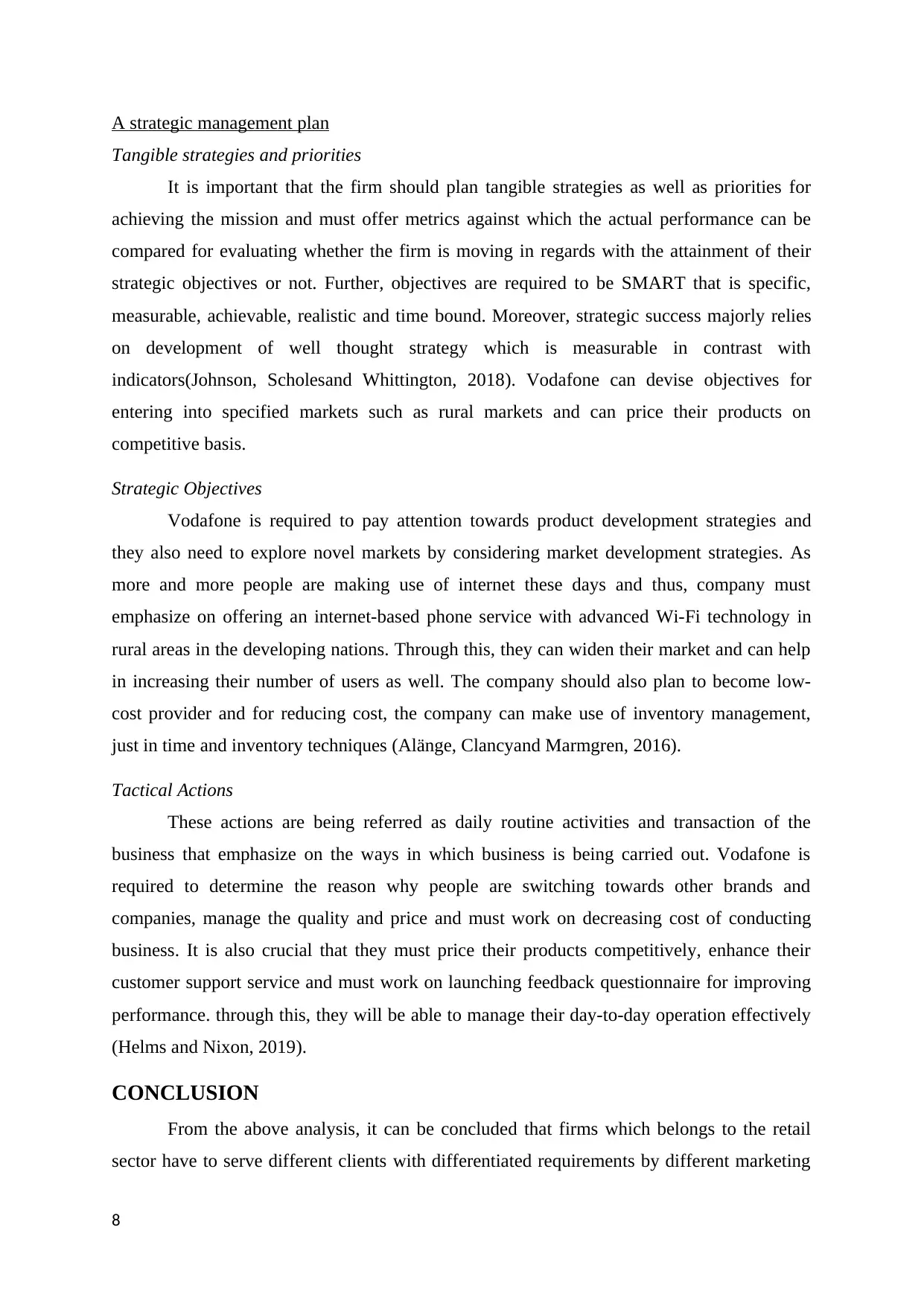
A strategic management plan
Tangible strategies and priorities
It is important that the firm should plan tangible strategies as well as priorities for
achieving the mission and must offer metrics against which the actual performance can be
compared for evaluating whether the firm is moving in regards with the attainment of their
strategic objectives or not. Further, objectives are required to be SMART that is specific,
measurable, achievable, realistic and time bound. Moreover, strategic success majorly relies
on development of well thought strategy which is measurable in contrast with
indicators(Johnson, Scholesand Whittington, 2018). Vodafone can devise objectives for
entering into specified markets such as rural markets and can price their products on
competitive basis.
Strategic Objectives
Vodafone is required to pay attention towards product development strategies and
they also need to explore novel markets by considering market development strategies. As
more and more people are making use of internet these days and thus, company must
emphasize on offering an internet-based phone service with advanced Wi-Fi technology in
rural areas in the developing nations. Through this, they can widen their market and can help
in increasing their number of users as well. The company should also plan to become low-
cost provider and for reducing cost, the company can make use of inventory management,
just in time and inventory techniques (Alänge, Clancyand Marmgren, 2016).
Tactical Actions
These actions are being referred as daily routine activities and transaction of the
business that emphasize on the ways in which business is being carried out. Vodafone is
required to determine the reason why people are switching towards other brands and
companies, manage the quality and price and must work on decreasing cost of conducting
business. It is also crucial that they must price their products competitively, enhance their
customer support service and must work on launching feedback questionnaire for improving
performance. through this, they will be able to manage their day-to-day operation effectively
(Helms and Nixon, 2019).
CONCLUSION
From the above analysis, it can be concluded that firms which belongs to the retail
sector have to serve different clients with differentiated requirements by different marketing
8
Tangible strategies and priorities
It is important that the firm should plan tangible strategies as well as priorities for
achieving the mission and must offer metrics against which the actual performance can be
compared for evaluating whether the firm is moving in regards with the attainment of their
strategic objectives or not. Further, objectives are required to be SMART that is specific,
measurable, achievable, realistic and time bound. Moreover, strategic success majorly relies
on development of well thought strategy which is measurable in contrast with
indicators(Johnson, Scholesand Whittington, 2018). Vodafone can devise objectives for
entering into specified markets such as rural markets and can price their products on
competitive basis.
Strategic Objectives
Vodafone is required to pay attention towards product development strategies and
they also need to explore novel markets by considering market development strategies. As
more and more people are making use of internet these days and thus, company must
emphasize on offering an internet-based phone service with advanced Wi-Fi technology in
rural areas in the developing nations. Through this, they can widen their market and can help
in increasing their number of users as well. The company should also plan to become low-
cost provider and for reducing cost, the company can make use of inventory management,
just in time and inventory techniques (Alänge, Clancyand Marmgren, 2016).
Tactical Actions
These actions are being referred as daily routine activities and transaction of the
business that emphasize on the ways in which business is being carried out. Vodafone is
required to determine the reason why people are switching towards other brands and
companies, manage the quality and price and must work on decreasing cost of conducting
business. It is also crucial that they must price their products competitively, enhance their
customer support service and must work on launching feedback questionnaire for improving
performance. through this, they will be able to manage their day-to-day operation effectively
(Helms and Nixon, 2019).
CONCLUSION
From the above analysis, it can be concluded that firms which belongs to the retail
sector have to serve different clients with differentiated requirements by different marketing
8
Paraphrase This Document
Need a fresh take? Get an instant paraphrase of this document with our AI Paraphraser
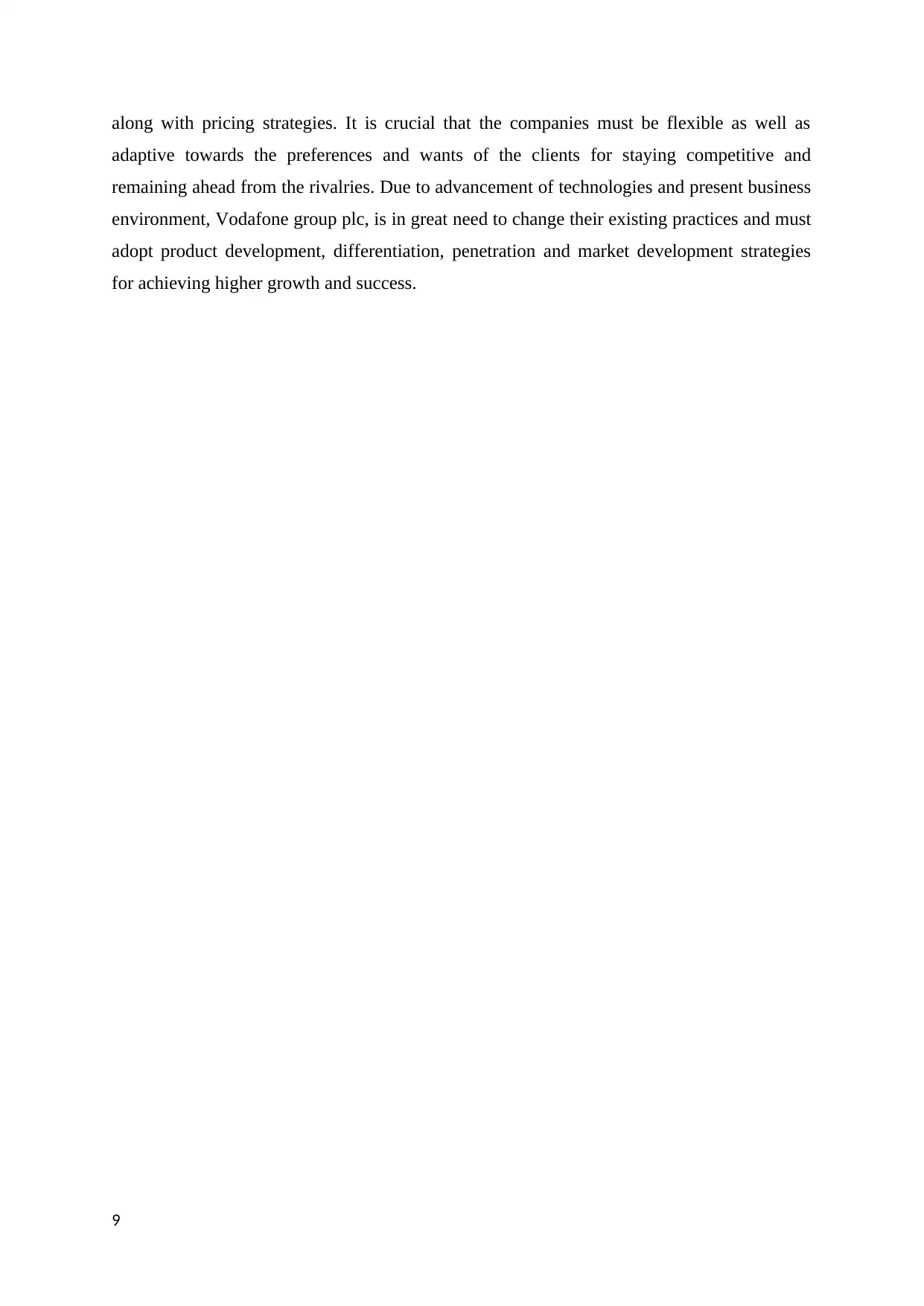
along with pricing strategies. It is crucial that the companies must be flexible as well as
adaptive towards the preferences and wants of the clients for staying competitive and
remaining ahead from the rivalries. Due to advancement of technologies and present business
environment, Vodafone group plc, is in great need to change their existing practices and must
adopt product development, differentiation, penetration and market development strategies
for achieving higher growth and success.
9
adaptive towards the preferences and wants of the clients for staying competitive and
remaining ahead from the rivalries. Due to advancement of technologies and present business
environment, Vodafone group plc, is in great need to change their existing practices and must
adopt product development, differentiation, penetration and market development strategies
for achieving higher growth and success.
9

REFERENCES
Books and journals
Alänge, S., Clancy, G. and Marmgren, M., 2016. Naturalizing sustainability in product
development: A comparative analysis of IKEA and SCA. Journal of Cleaner
Production. 135, pp.1009-1022.
Bohm, A., 2019. The SWOT analysis, GRIN Verlag, Norderstedt.
Chang, W., Ellinger, A.E., Kim, K.K. and Franke, G.R., 2016. Supply chain integration and
firm financial performance: A meta-analysis of positional advantage mediation and
moderating factors. European Management Journal. 34(3). pp.282-295.
Halbert, T. and Ingulli, E., 2014. Law and Ethics in the Business Environment. Pearson
education.
Helms, M.M. and Nixon, J., 2019. Exploring SWOT analysis - where are we now? A review
of academic research from the last decade. Journal of Strategy and Management3(3).
p.215.
Johnson,G., 2011. Fundamentals of Strategy. 2nded. Financial Times/Prentice Hall.
Johnson, G., Scholes, K. and Whittington, R., 2018. Exploring corporate strategy. London:
Financial Times Prentice Hall.
Kim, W.C. and Mauborgne, R., 2015. Blue Ocean Strategy. Expanded Ed. Boston: Harvard
Business Review Press.
Ramaswamy, V. andOzcan, K., 2016. Brand value co-creation in a digitalized world: An
integrative framework and research implications. International Journal of Research in
Marketing. 33(1). pp.93-106.
Rothaermel, F., 2014. Strategic Management. 2nded. Maidenhead: McGraw-Hill.
Sweney, M., 2020. Vodafone reports 50% rise in internet use as more people work from
home. The Guardian, Web.
Vesa, J., 2015. Mobile services in the networked economy. New York: Idea Group Inc (IGI).
Yoo, S.H. andSeo, Y.W., 2017. Effect of supply chain structure and power dynamics on
R&D and market performances. Journal of Business Economics and Management.
18(3). pp. 487-504.
Chowdhury, Dhar, B.K. and Stasi, A., 2022. Volatility of the US stock market and business
strategy during COVID‐19. Business Strategy & Development.
10
Books and journals
Alänge, S., Clancy, G. and Marmgren, M., 2016. Naturalizing sustainability in product
development: A comparative analysis of IKEA and SCA. Journal of Cleaner
Production. 135, pp.1009-1022.
Bohm, A., 2019. The SWOT analysis, GRIN Verlag, Norderstedt.
Chang, W., Ellinger, A.E., Kim, K.K. and Franke, G.R., 2016. Supply chain integration and
firm financial performance: A meta-analysis of positional advantage mediation and
moderating factors. European Management Journal. 34(3). pp.282-295.
Halbert, T. and Ingulli, E., 2014. Law and Ethics in the Business Environment. Pearson
education.
Helms, M.M. and Nixon, J., 2019. Exploring SWOT analysis - where are we now? A review
of academic research from the last decade. Journal of Strategy and Management3(3).
p.215.
Johnson,G., 2011. Fundamentals of Strategy. 2nded. Financial Times/Prentice Hall.
Johnson, G., Scholes, K. and Whittington, R., 2018. Exploring corporate strategy. London:
Financial Times Prentice Hall.
Kim, W.C. and Mauborgne, R., 2015. Blue Ocean Strategy. Expanded Ed. Boston: Harvard
Business Review Press.
Ramaswamy, V. andOzcan, K., 2016. Brand value co-creation in a digitalized world: An
integrative framework and research implications. International Journal of Research in
Marketing. 33(1). pp.93-106.
Rothaermel, F., 2014. Strategic Management. 2nded. Maidenhead: McGraw-Hill.
Sweney, M., 2020. Vodafone reports 50% rise in internet use as more people work from
home. The Guardian, Web.
Vesa, J., 2015. Mobile services in the networked economy. New York: Idea Group Inc (IGI).
Yoo, S.H. andSeo, Y.W., 2017. Effect of supply chain structure and power dynamics on
R&D and market performances. Journal of Business Economics and Management.
18(3). pp. 487-504.
Chowdhury, Dhar, B.K. and Stasi, A., 2022. Volatility of the US stock market and business
strategy during COVID‐19. Business Strategy & Development.
10
⊘ This is a preview!⊘
Do you want full access?
Subscribe today to unlock all pages.

Trusted by 1+ million students worldwide
1 out of 13
Related Documents
Your All-in-One AI-Powered Toolkit for Academic Success.
+13062052269
info@desklib.com
Available 24*7 on WhatsApp / Email
![[object Object]](/_next/static/media/star-bottom.7253800d.svg)
Unlock your academic potential
Copyright © 2020–2025 A2Z Services. All Rights Reserved. Developed and managed by ZUCOL.





